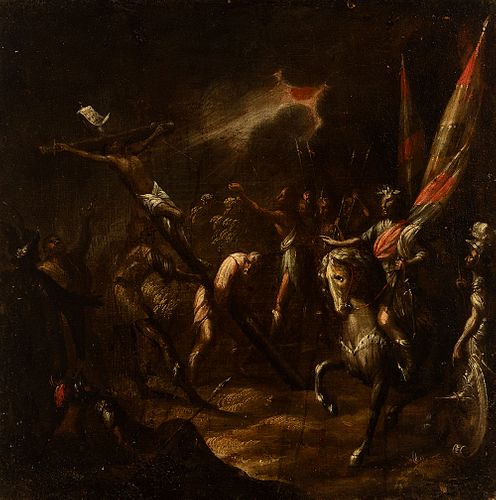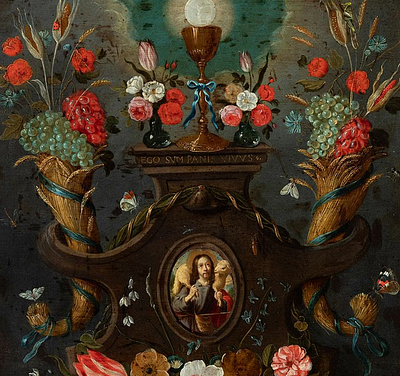Workshop of ANTONIO DEL CASTILLO Y SAAVEDRA (Cordoba, 1616 - 1668). "The Elevation of the Cross". Oil on canvas. Relined.
Lot 26
About Seller
Setdart Auction House
Carrer Aragó 346
Barcelona
Spain
Setdart Subastas was born in 2004 and is currently the first online art auction in Spain with solidity, prestige and reliability guaranteed by our more than 60,000 users. Setdart has a young, dynamic and enterprising team ready to successfully manage the purchase and sale of art works through custom...Read more
Estimate:
EUR€2,000 - EUR€3,000
$2,105.26 - $3,157.89
Absentee vs Live bid
Two ways to bid:
- Leave a max absentee bid and the platform will bid on your behalf up to your maximum bid during the live auction.
- Bid live during the auction and your bids will be submitted real-time to the auctioneer.
Bid Increments
| Price | Bid Increment |
|---|---|
| EUR€0 | EUR€10 |
| EUR€200 | EUR€25 |
| EUR€500 | EUR€50 |
| EUR€1,000 | EUR€100 |
| EUR€3,000 | EUR€200 |
| EUR€5,000 | EUR€500 |
| EUR€10,000 | EUR€1,000 |
| EUR€20,000 | EUR€2,000 |
| EUR€50,000 | EUR€5,000 |
About Auction
By Setdart Auction House
Sep 21, 2021
Set Reminder
2021-09-21 10:00:00
2021-09-21 10:00:00
America/New_York
Bidsquare
Bidsquare : 21st September - ARAS JÁUREGUI Private Collection - Old Masters, 19th & 20th Century
https://www.bidsquare.com/auctions/setdart-auction-house/21st-september---aras-j-uregui-private-collection---old-masters-19th-20th-century-7429
Setdart Auction House sofia@setdart.com
Setdart Auction House sofia@setdart.com
- Lot Description
Workshop of ANTONIO DEL CASTILLO Y SAAVEDRA (Cordoba, 1616 - 1668). "The Elevation of the Cross". Oil on canvas. Relined. Size: 60,5 x 60,5 cm. In this work that would be part of a representative group of the Way of the Cross, the elevation of the cross is represented in complete darkness, only torn by the banners that are part of the image, in which a scene of great dramatism is developed. Christ, already nailed to the cross, is lifted up by several men who try to hoist the structure. Darkness hovers over Christ's body, which is notable for the elongation of his anatomy and the languor of his body, with his face fallen, leaning on the wood of the cross, dejected and surviving the last breath of his mortal life. The scene is completed by a group of figures in the lower part, who form part of the Roman SPQR (The Senate and the Roman People), headed by a laureate equestrian figure carrying a large standard, who seems to be leading Christ's condemnation. All these figures are arranged in a concave, elliptical composition, inviting the viewer to become part of the scene. In addition, the figure of Christ is displaced from the centre, thus attracting the observer to the centre, which is illuminated by a warm light of Tenebrist heritage. This void allows the scene to be rationalised and ordered, with the figures standing out for their movement, foreshortening and the diagonal lines that follow the position of their bodies. Because of these characteristics, added to the drama of the pictorial palette, the piece is reminiscent of the aesthetic precepts of Antonio del Castillo. Antonio Castillo is considered to be the father of the Cordovan school of painting, and was also a polychromator and designer of architectural, decorative and goldsmithing projects. He was the son of Agustín del Castillo, a little-known painter from Llerena (Extremadura) whom Palomino describes as "an excellent painter". It is also thought that he may have trained as a polychromator in Calderón's workshop. However, he was orphaned when he was only ten years old in 1626 and went on to train in the workshop of another painter of whom we have no record, Ignacio Aedo Calderón. Although there is no real evidence of this, it is thought that he may have arrived in Seville, where, according to Palomino, he entered Zurbarán's workshop. This has been corroborated by the stylistic influence of the Extremaduran master that historians have seen in Castillo's work. However, in 1635 he returned to his native Cordoba, where he married and settled permanently, eventually becoming the city's most important artist without question. His fame and quality earned him important commissions, including religious altarpieces, portraits and medium-format series. He was also the teacher of outstanding Cordoban painters of the following generation, such as Juan de Alfaro and Gámez. With regard to his language, Antonio del Castillo did not develop an obvious evolution in his work, although towards the end of his life a more softened language can be discerned, and he remained on the fringes of the baroque innovations of other contemporary painters. However, like the rest of his contemporaries, he was seduced by the novelty of Murillo's work and in his last years introduced the Venetian chromatic softness of the Sevillian master. Generally speaking, in his religious figures he remained closer to strict naturalism,
- Shipping Info
-
In-house shipping available. Please inquire at admin@setdart.com.
-
- Buyer's Premium



 EUR
EUR CAD
CAD AUD
AUD GBP
GBP MXN
MXN HKD
HKD CNY
CNY MYR
MYR SEK
SEK SGD
SGD CHF
CHF THB
THB















